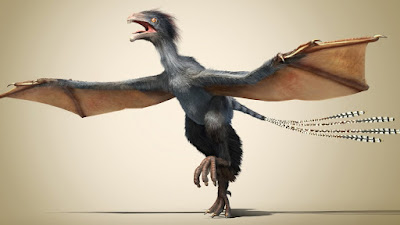Type Species: Yi qi
Classification: Dinosauria – Saurischia – Theropoda – Coelurosauria – Maniraptora – Paraves – Scansoriopterygidae
Time Period: Late Jurassic
Location: China
Diet: Carnivore
The Tiaojishan Formation of China captures a snapshot of a mountainous, jungle-like, subtropical paradise dominated by bennettitales, ginkgoes, conifers, and ferns. The environment was cut by mountain streams, hollowed-out azure lakes, and active volcanoes. Yi is known from a single adult specimen. It weighed less than a pound and was likely arboreal (tree-dwelling). Its head was short and blunt-snouted with a downturned lower jaw. It had teeth only in the tips of the jaws: the four upper teeth were the largest and slightly forward-pointing, and the four lower teeth were angled even more strongly forward. It had long, slender forearms and was covered in a thick coat of feathers. Its feathers were stiff and simple in structure; they were ‘paintbrush-like,’ with long quill-like bases topped by sprays of inner filaments. The feathers started near the tip of the snout and spread down to the metatarsus of the foot. The head and neck feathers were long, and the body feathers were even longer and thicker. The longest feathers were six centimeters behind the upper arm and shinbone. Electron microscope studies of preserved melanosomes revealed that the body feathers were black while the head feathers had a more yellowish-brown hue.
Yi’s most interesting characteristic was a bat-like membrane of skin that served for gliding. It had an unusually elongated third finger that supported the membranous gliding pane of skin, which was preserved as small patches of wrinkled skin. These bat-like wings were supported by a long, bony strut attached to the wrist. This arrangement is unique among all known dinosaurs and makes Yi quite an interesting find. At least one other scansoriopterygid, Ambopteryx, appears to have had a similar bat-like membranous wing. They are not related to bats, which are mammals.




No comments:
Post a Comment